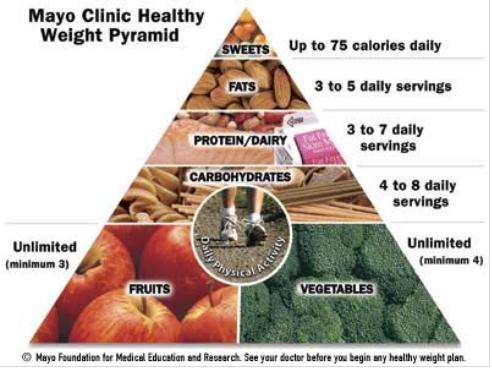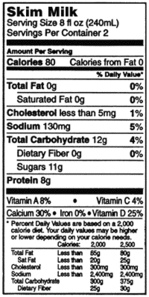Rummaging through my daughter’s school book sale yesterday, I spied and dug out a copy of the Mayo Clinic’s: The Essential Diabetes Guide 2010. I reached into my pocket, pulled out a buck and paid the friendly but frazzled public school volunteer.
Flipping through it, I paused at Chapter 3, Developing a Healthy Eating Plan. As I turned the pages, I was instantly inundated with loads of colorful pictures of the kinds of foods the Mayo Clinic thinks people with diabetes should be eating. What struck me as odd was that almost every picture was of a carbohydrate – fruits, pasta, muffins, salads, tacos shells, whole grain bread, tortillas, and cereals. I found this intellectually disturbing.
Last time I checked, diabetes was a condition of carbohydrate intolerance. Not fat or protein intolerance, carbohydrate intolerance. In fact, the Mayo Clinic agrees with this definition in their guide book. On pages 8&9 it states:
The term diabetes refers to a group of diseases that affect the way your body uses blood glucose, commonly called blood sugar. If you have diabetes – no matter what type – it means you have too much glucose in your blood although the reasons why may differ…If you have diabetes, this process doesn’t work properly. Instead of being transported into your cells, excess glucose builds up in your bloodstream…
Well, the main reason why a person would have too much blood glucose is if they ate too much carbohydrate. If you don’t eat carbohydrate, you can’t have too much blood glucose.
But hey, let’s not sweat the details.
Interestingly, there isn’t a separate chapter on the causes of diabetes. The guide book discusses what diabetes is, the different types, signs, symptoms, risks, dangers, etc. but gives scant mention as to the causes. While they describe the pathology in the “Types” section, there is no specific chapter on why you might have developed diabetes in the first place. I find this curious. You’d think this would be the most important chapter to people interested in learning about the disease.
There is enormous discussion on how a diabetic can’t deal with blood sugar without ever talking about why there is so much sugar in a diabetic’s blood. They make it seem as if it’s just there – as if a diabetic wakes up in the morning with her blood full of glucose which apparently lasts all day long. Are diabetics followed around by little sugar goblins carrying hypos filled with glucose who secretly inject them with it?
Let’s now investigate why a diabetic’s blood is aswirl with sugar.
Take a look at the Mayo Clinic’s Healthy Weight Pyramid:

The bottom of their pyramid is fruits and vegetables (carbohydrates) all of which convert to glucose (except for the fiber) once digested. And for these two food groups, they allow the diabetic to eat an unlimited quantity of them. In other words, if you’re a diabetic and you fancy eating an entire bag of grapes and a half dozen carrots, you go girl.
Above this is section is a smaller section they call ‘carbohydrates,’ as if fruits and vegetables are not carbohydrates but some other form of macro-nutrient. Why not say “grain?” Why the separation? (Seems sort of sneaky to me.) For this food group, you could choose to eat eight servings of pasta if you like. Eight servings of pure sugar that is.
A sweet pattern is emerging, yes?
Above this is protein and dairy. Dairy can, and often does, contain a good deal of carbohydrate especially low fat dairy products such as skimmed milk which is what the Mayo Clinic endorses. Skimmed milk is mostly sugar. Take a look at the label on the back of your skim or low fat milk right now. Ah heck, why bother taking the time. Here’s the label below:
As you can see, a cup of skim milk is really just a cup of sugar in disguise. There’s 12 grams of carbohydrates and 11 grams of sugar in a single cup. The normal amount of circulating blood glucose in the typical adult is about a teaspoon or about 4 grams. Eleven grams of ingested sugar is twofold more circulating glucose than is normal. For someone without diabetes this might be easy to handle, but for someone with diabetes, this is nasty.
And while protein can raise insulin levels, it does not raise blood sugar which is the real danger. In fact, research done by Frank Nuttal (the man who has probably done the most research on high protein diets) says that protein (and fat) has no effect on blood glucose concentration in non-diabetics and decreases blood glucose in diabetics because of an increased insulin response. From the study:
Dietary glucose strongly stimulates insulin secretion…Fats most likely have little or no effect on either glucose or insulin. Finally, reducing the glucose content of the diet and increasing the protein and fat content should reduce the postprandial plasma glucose concentration in people with diabetes.
I guess the Mayo Clinic missed the memo. (Hat tip to Gary Taubes for bringing this to my attention.)
Near the top of the Mayo Clinic’s pyramid is fats – a critical macronutrient that does not increase blood glucose in the least. Fat is a veritable macronutrient savior for diabetics, if ever there was one. But for some reason the Mayo Clinic warns the diabetic to limit fats (even though there is no scientific evidence to warrant such a recommendation) in favor of carbohydrates – the macronutrient that increases blood glucose the most. (Pardon me while I go and scratch my head for an hour on this one.)
At the top of the pyramid is sweets – meaning pure sugar. That the Mayo Clinic would include sweets at all in their “healthy” food pyramid is very odd indeed. Imagine creating a “body health pyramid” and putting cigarettes at the top. “Limit to 1-2 servings daily.” ‘Nuff said on that.
So if you add it all up, we see that the Mayo Clinic, who tells us that diabetes is a problem of too much blood glucose (which we now know is caused by the ingestion of carbohydrates), suggests that the diabetic eat most of her calories as – drum roll please – carbohydrates! Rather than a dietary solution to diabetes, wouldn’t this instead be how one might cause it (type 2 specifically)?
Let us now take a moment of silence to honor the fallen diabetics who have succumbed to such a brilliant plan.
*
But I don’t find this situation funny at all, any more than you do. That’s why I wrote this post.
OK moving on. Let’s take a closer look as to what might be causing this deadly disconnect. I mean, surely the Mayo Clinic is made up of honest, caring people who want this terrible disease stopped dead in it’s tracks, right?
On page 9, the Mayo Clinic guide states:
When the level of insulin in your blood is high, such as after a meal,…
Something seems to be missing here, right? A word, perhaps? After a meal? After a meal of what pray tell? A meal of sausage? Nope. A meal of eggs cooked in pure lard? No. After a meal of – you guessed it – carbohydrate. Why the omission of the word carbohydrate? Here’s why.
On page 35, under the heading “What’s Healthy Eating?” we find a section called “Carbohydrates: The Foundation.” The foundation. See? Now we’re getting somewhere. Since the Mayo Clinic suggests that up to 65% of your calories should come from carbohydrates, it’s no wonder a diabetics blood sugar is “high after a meal…”
Had they said: “When the level of insulin in your blood is high, such as after a carbohydrate rich meal…” I’d venture to say that everyone would get it and type 2 diabetes would all but vanish from the Earth in a matter of months.
The Dietary Reference Intakes known as the DRI’s, generated by The Institute of Medicine, state the following:
The lower limit of dietary carbohydrate compatible with life apparently is zero, provided that adequate amounts of protein and fat are consumed.
Zero means none. Zippo. Nada. Given this and knowing that diabetes is a disorder of glucose intolerance, how then, or rather, why then does the Mayo Clinic recommend that a diabetic eat so much carbohydrate when nary a gram is necessary at all?
So there you have it. And though this post has been a touch flippant here and there, please don’t take this information lightly. In the time it took you to read this, someone’s grandmother lost her eyesight and someone’s father lost his feet to diabetes. And all because no professional told them to severely limit their carbohydrate intake. On the contrary, grandma and dad were told to fill their bellies with them.
One has to wonder – does the Mayo Clinic want this country to be free of diabetes or riddled with it?
To sum up:
- Diabetes is a condition of carbohydrate (blood glucose) intolerance
- Carbohydrate is the food source that converts to glucose in your blood
- Carbohydrate is not a necessary nutrient so long as adequate fat and protein are eaten
- Fat and protein do not increase blood glucose (nor does fat contribute to heart disease)
Now, as a diabetic, what do you think you should be eating? As a non-diabetic wanting to avoid getting diabetes, what do you think you should be eating as well?
And if you are a diabetic, once you adopt a diet that is low in carbohydrate, you may no longer need your glucometer – or your medications.
What sorts of health care solutions is President Obama looking for? This sort I think.
The legendary humorist Mark Twain once said: “The truth is easy to kill but a lie well told is immortal.” The lie, or rather, the innocently ignorant fib the Mayo Clinic is telling diabetics is that you need to flood your blood with sugar in order to manage your diabetes. I’m sure once they release their old ideas and see the error of their ways, they’ll apologize to the American people and start recommending a low carbohydrate/sugar diet. They’ll have to or it could (and should) be considered a form of ‘malpractice.’
I think we now know the true dietary road to rid ourselves of this terrible disease. If I have helped even one person cure their diabetes with this post, I have done my job. Hopefully, I will have helped an entire nation. (But if this comes to pass, it’s no thanks to me…it’s thanks to science.) Please share this post with anyone you know who is diabetic. It will save their eyes, their limbs and perhaps their life.
For more information, please visit the Nutrition and Metabolism Society.












